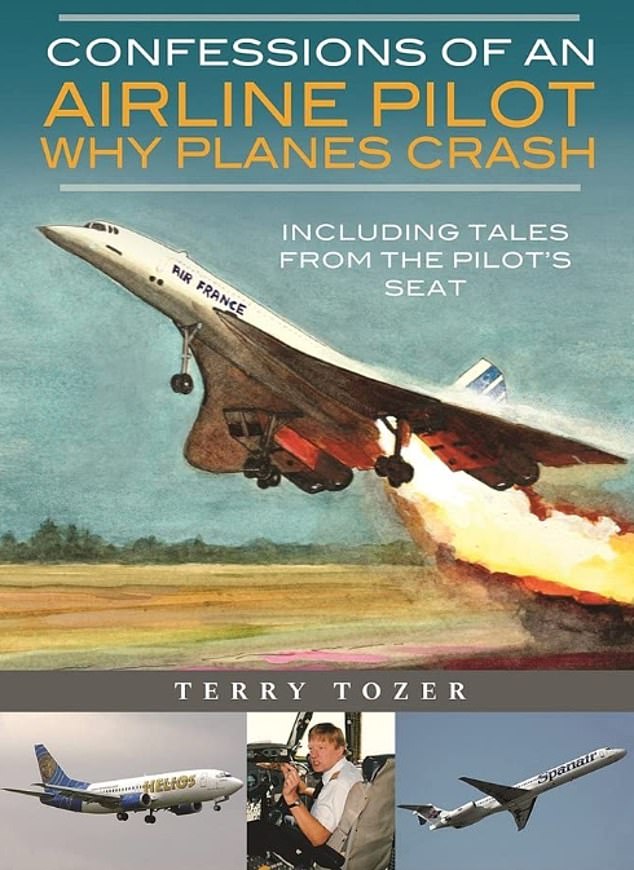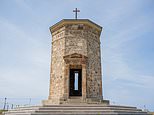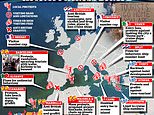- Here one former pilot reveals why lightning is nothing more than a 'nuisance'
- Lightning causing a plane to crash is very rare - but it has happened
- READ MORE: Why the act of 'rawdogging' flights has mental-health benefits
Dramatic footage captured the moment a British Airways plane was struck by lightning on its approach to Heathrow Airport on Sunday.
One passenger described the event as 'shocking'.
But how worried should passengers be if their plane is struck by lightning?
Not very worried at all is the answer from the experts. Here veteran former pilot Terry Tozer, author of Confessions of an Airline Pilot - Why Planes Crash, Air Canada captain Doug Morris and James Moy, a flying instructor at Flight Sport Aviation, reveal how common lightning strikes are and what happens to a plane when it's struck by a bolt.
How common are lightning strikes on planes?

Dramatic footage captured the moment a British Airways plane was struck by lightning on its approach to Heathrow Airport on Sunday
Writing in his book This Is Your Captain Speaking, Doug Morris explains: 'Statistics show an airliner gets hit [by lightning] every 5,000 hours, or about once a year. The FAA estimates every airliner in the U.S will be struck once a year.'
What happens to a plane when it's hit by lightning?
Not much at all, reveals Terry, who explained: 'A lightning strike can upset some of the instruments but it's not usually a really serious issue because the aircraft isn't earthed. You can have lightning going in one end and out the other and there might only be superficial damage.
'I've only experienced it once – we had a tiny hole in the nose cone and the exit point in the tail had burnt through a small piece of the tailfin support, so it had to be taken out of service.
'It was ok for a temporary flight without passengers.
'After a lightning strike, it's likely you'd need the aircraft checked over to make sure all the compasses and electronics haven't gone haywire.'
What do the pilots do when the plane is hit by lightning? Would they be aware of it?
![Writing in his book This Is Your Captain Speaking, Doug Morris (above) explains: 'Statistics show an airliner gets hit [by lightning] every 5,000 hours, or about once a year. The FAA estimates every airliner in the U.S will be struck once a year'](https://i.dailymail.co.uk/1s/2024/07/08/13/68501575-13612011-High_flyer_Veteran_Air_Canada_Dreamliner_captain_Doug_Morris-a-11_1720443210809.jpg)
Writing in his book This Is Your Captain Speaking, Doug Morris (above) explains: 'Statistics show an airliner gets hit [by lightning] every 5,000 hours, or about once a year. The FAA estimates every airliner in the U.S will be struck once a year'
Terry said: 'Probably, but it depends what happens. You could be flying in cloud and see a bright flash, but you wouldn't necessarily know that it had hit you, unless there was some other indication, like instruments behaving oddly or something like that.'
James commented: 'The lightning strike may cause a temporary disruption in communication or navigation systems, but modern aircraft are equipped to withstand and dissipate the energy from a lightning strike. The plane's systems are designed to continue operating normally after a lightning strike.'
Can pilots anticipate a lightning strike?
Terry said: 'Normally, on a modern aircraft, such as the last regional jet I flew, there is lightning detecting equipment as well as weather radar.
'Lightning normally comes from cumulonimbus thunderstorm clouds and they normally paint on the radar.
'You do occasionally get "dry storms", which if they don't have enough moisture in them to show up on radar could surprise you.
'But if you've got lightning detectors, they usually show you where the lightning is.'
What might passengers experience?
Terry said: 'There have been dramatic tales of balls of lightning travelling down the cabin from one end to the other, no doubt terrifying everybody.
'But it's not likely to do anything drastic.'
Should passengers be worried?
Terry said: 'Not really. Your job at the pointy end is risk management, so it's less than an ideal situation to be struck by lightning, so obviously you would try and avoid it.
'It would probably be worse if you ran into heavy hail, because that can actually do physical damage to the aircraft.
'We've seen nose cones smashed and windows damaged. But hail ought to show up on your weather radar.
'The weather is both powerful and unpredictable and you can never completely eliminate all risk.
'But generally speaking, lightning is something that most modern aircraft are capable of dealing with.'
James concurred: 'The pilot may communicate with passengers, providing reassurance and updates as needed, but generally, there is no cause for alarm. Passengers should feel confident in the aircraft's ability to withstand lightning strikes.'
Terry added that lightning is usually nothing more than a 'bl***y nuisance... because if the aircraft is affected and it needs to have the compasses swung again and reset and then it’s out of service, the whole schedule is disrupted... it’s not going to destroy vital structures or anything like that'.

Veteran former pilot Terry Tozer, author of Confessions of an Airline Pilot - Why Planes Crash, told MailOnline that lightning is usually nothing more than a 'nuisance'

























































































































